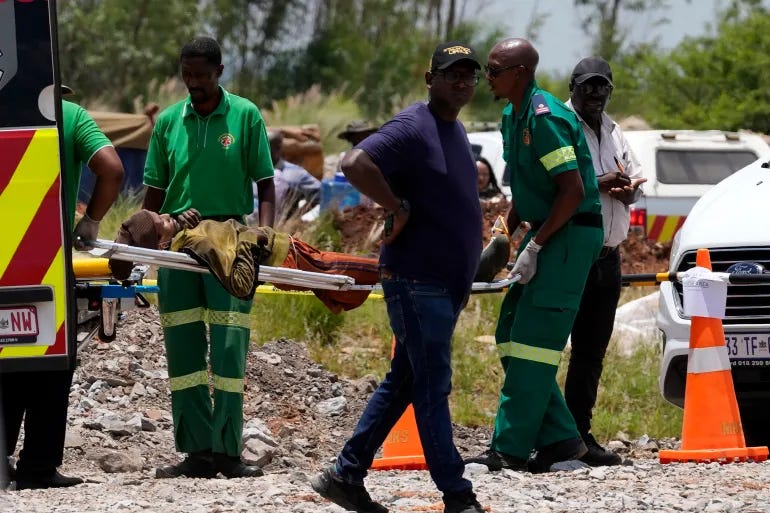'Massacre': Did South Africa Starve Dozens of Trapped Miners to Death?
Rights groups claim police used starvation as a tactic to force illegal miners out of Stilfontein, leading to nearly 80 deaths.
A standoff between South African authorities and illegal miners trapped in the Stilfontein mine has ended in tragedy, with at least 78 miners believed to have died from starvation, according to rights groups. The rescue operation, which had been underway for months, was officially concluded this week, and although 246 survivors were pulled from the depths of the abandoned mine, human rights organizations are condemning the government for its slow response and failure to prevent the deaths.
The Stilfontein mine, located in North West Province, became the site of a crisis when police surrounded it in September, cutting off food and water supplies to hundreds—if not thousands—of miners trapped underground. Activists argue that authorities deliberately used starvation to force the miners out of the tunnels, an approach they describe as a "massacre."
What Happened?
The miners, many of whom are believed to be from neighboring countries such as Mozambique, Zimbabwe, and Lesotho, had been searching for precious metals in a mine deemed unsafe and no longer operational. Once trapped, the miners faced harrowing conditions without sufficient provisions, and despite repeated pleas from families and community members for a rescue mission, authorities took little action until court intervention in October.
A court order eventually allowed some supplies to reach the miners, but delays continued. When bodies began to surface in the mine, civil rights groups filed lawsuits, demanding a full-scale rescue. A recent court ruling forced the police to expedite the evacuation, but by then, many lives had already been lost.
Why Did the Government Delay Action?
South African officials argue that the miners' deaths were not the police's fault, shifting blame to the criminals operating the illegal mining rings. However, rights groups contend that the government’s actions were both irresponsible and inhumane, accusing them of using starvation as a tool to evict the miners.
In the months leading up to the rescue, police executed an operation called "Close the Hole," which aimed to seal off the mine’s shafts and force out the miners. Despite the mounting humanitarian crisis, authorities refused to intervene until a court-ordered operation was launched in January.
What Are Rights Groups Saying?
Civil rights groups and mining advocates are demanding accountability for the deaths. The Mining Affected Communities United in Action (MACUA) labeled the crisis a “massacre” and called it a gross violation of human rights. They accused the South African government of xenophobia, alleging that the miners—many of whom were foreign nationals—were denied basic rights simply because of their status as illegal migrants.
“They were treated as expendable, and the government acted with deliberate cruelty,” said Magnificent Mndebele, a spokesperson for MACUA. “This is not just a failure of the state; it’s a disregard for the right to life.”
The Path Forward
As the survivors receive medical treatment and prepare for legal proceedings, questions remain about the responsibility of both the government and the mine’s owners, Buffelsfontein Gold Mine, which has faced criticism for not securing the site. Meanwhile, South Africa's opposition parties are demanding a thorough investigation into the events, with the Democratic Alliance (DA) calling for President Cyril Ramaphosa to act quickly before key witnesses are lost.
The full scope of the tragedy is still emerging, but one thing is clear: the slow and delayed response from South African authorities has sparked outrage, and many are calling for justice to prevent such a catastrophe from happening again.


